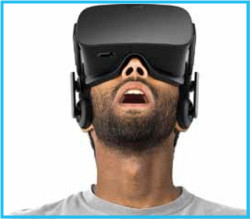By Kevin R. Donley, kevin@multimediaman.org
 On November 2, video game maker Activision Blizzard Entertainment announced a $5.9 billion purchase of King Digital Entertainment, maker of the mobile app game Candy Crush Saga. Activision Blizzard owns popular titles like Call of Duty, World of Warcraft and Guitar Hero—with tens of millions sold—for play on game consoles and PCs. By comparison, King has more than 500 million worldwide users playing Candy Crush on TVs, computers and (mostly) mobile devices.
On November 2, video game maker Activision Blizzard Entertainment announced a $5.9 billion purchase of King Digital Entertainment, maker of the mobile app game Candy Crush Saga. Activision Blizzard owns popular titles like Call of Duty, World of Warcraft and Guitar Hero—with tens of millions sold—for play on game consoles and PCs. By comparison, King has more than 500 million worldwide users playing Candy Crush on TVs, computers and (mostly) mobile devices.
While it is not the largest-ever acquisition of a game company—Activision bought Blizzard in 2008 for $19 billion— the purchase shows how much the traditional gaming industry believes that future success will be tied to mobile and social media. Other recent acquisitions indicate how the latest in gaming hardware and software have become strategically important for the largest tech companies:
• September 2014: Microsoft acquired Mojang for $2.5 billion. Mojang’s Minecraft game has 10 million users worldwide and an active developer community. The Lego-like Minecraft is popular on both Microsoft’s Xbox game console and Windows desktop and notebook PCs. In making the purchase, Microsoft CEO Satya Nadella said, “Gaming is a top activity spanning devices, from PCs and consoles to tablets and mobile, with billions of hours spent each year.”
• August 2104: Amazon acquired Twitch for $970 million. The massive online retailer has offered online video since 2006 and the purchase of Twitch—the online and live streaming game service—adds 45 million users to Amazon’s millions of Prime Video subscribers and FireTV (stick and set top box) owners.
Amazon’s CEO Jeff Bezos said of the acquisition, “Broadcasting and watching gameplay is a global phenomenon and Twitch has built a platform that brings together tens of millions of people who watch billions of minutes of games each month.”
• March 2014: Facebook acquired Oculus for $2 billion. Facebook users take up approximately 20% of all the time that people spend online each day. The Facebook acquisition of Oculus—maker of virtual reality headsets—is an anticipation that social media will soon include an immersive experience as opposed to scrolling through rectangular displays on PCs and mobile devices. According to Facebook CEO Mark Zuckerberg, “Mobile is the platform of today and now we’re also getting ready for the platforms of tomorrow. Oculus has the chance to create the most social platform ever and change the way we work, play and communicate.”
• March 2014: Facebook acquired Oculus for $2 billion. Facebook users take up approximately 20% of all the time that people spend online each day. The Facebook acquisition of Oculus—maker of virtual reality headsets—is an anticipation that social media will soon include an immersive experience as opposed to scrolling through rectangular displays on PCs and mobile devices. According to Facebook CEO Mark Zuckerberg, “Mobile is the platform of today and now we’re also getting ready for the platforms of tomorrow. Oculus has the chance to create the most social platform ever and change the way we work, play and communicate.”
What is VR?
Among the most important current trends is the rapid growth and widespread adoption of virtual reality (VR). Formerly of interest to hobbyists and gaming enthusiasts, VR technologies are now moving into mainstream daily use.
A short definition of VR is a computer-simulated artificial world. More broadly, VR is an immersive multisensory, multimedia experience that duplicates the real world and enables users to interact with the virtual environment and with each other. In the most comprehensive VR environments, the sight, sound, touch and smell of the real world are replicated.
Current and most commonly used VR technologies include a stereoscopic headset—which tracks the movement of a viewer’s head in 3 dimensions—and surround sound headphones that add a spatial audio experience. Other technologies such as wired gloves and omnidirectional treadmills can provide tactile and force feedback that enhance the recreation of the virtual environment.
 Recent events have demonstrated that VR use is becoming more practical and accessible to the general public:
Recent events have demonstrated that VR use is becoming more practical and accessible to the general public:
• On October 13, in a partnership between CNN and NextVR, the presidential debate was broadcast in VR as a live stream and stored for later on demand viewing. The CNN experience made it possible for every viewer to watch the event as though they were present, including the ability to see other people in attendance and observe elements of the debate that were not visible to the TV audience. NextVR and the NBA also employed the same technology to broadcast the October 27 season opener between the Golden State Warriors and New Orleans Pelicans, the first-ever live VR sporting event.
• On November 5, The New York Times launched a VR news initiative that included the free distribution of Google Cardboard viewers—a folded up cardboard VR headset that holds a smartphone—to 1 million newspaper subscribers. The Times’ innovation required users to download the NYTvr app to their smartphone in order to watch a series of short news films in VR.
Origins of VR
Virtual reality is the product of the convergence of theater, film, television, science fiction and digital media. The basic ideas of virtual reality go back more than two hundred years and coincide with the desire of artists, performers and educators to recreate scenes and historical events. In the early days this meant painting panoramic views, constructing dioramas and staging theatrical productions where viewers had a 360 ̊ visual surround experience.
In the late 19th century, hundreds of cycloramas were built— many of them depicting major battles of the Civil War—where viewers sat in the center of a circular theater as the timeline of the historical event moved and was recreated around them in sequence. In 1899, a Broadway dramatization of the novel Ben Hur employed live horses galloping straight toward the audience on treadmills as a backdrop revolved in the opposite direction creating the illusion of high speed. Dust clouds were employed to provide additional sensory elements.
Contemporary ideas about virtual reality are associated with 3-D photography and motion pictures of the early twentieth century. Experimentation with color stereoscopic photography began in the late 1800s and the first widely distributed 3-D images were of the 1906 San Francisco earthquake and taken by Frederic Eugene Ives. As with present day VR, Ives’ images required both a special camera and viewing device called the Kromskop in order to see 3-D effect.
3-D photography was expanded and won popular acceptance beginning in the late 1930s with the launch of the View-Master of Edwin Eugene Mayer. The virtual experience of the View- Master system was enhanced with the addition of sound in 1970. Mayer’s company was eventually purchased by toy maker Mattel and later by Fischer-Price and the product remained successful until the era of digital photography in the early 2000s.
Experiments with stereoscopic motion pictures were conducted in the late 1800s. The first practical application of a 3-D movie took place in 1922 using the Teleview system of Laurens Hammond (inventor of the Hammond Organ) with a rotating shutter viewing device attached to the armrest of the theater seats.
Prefiguring the present-day inexpensive VR headset, the so-called “golden era” of 3-D film began in the 1950s and included cardboard 3-D glasses. Moviegoers got their first introduction to 3-D with stereophonic sound in 1953 with the film House of Wax starring Vincent Price. The popular enthusiasm for 3-D was eventually overtaken by the practical difficulties associated with the need to project two separate film reels in perfect synchronization.
 Subsequent waves of 3-D movies in the second half of the twentieth century—projected from a single film strip—were eventually displaced by the digital film and audio methods associated with the larger formats and Dolby Digital sound of Imax, Imax Dome, Omnimax and Imax 3D. Anyone who has experienced the latest in 3-D animated movies such as Avatar (2009) can attest to the mesmerizing impact of the immersive experience made possible by the latest in these movie theater techniques.
Subsequent waves of 3-D movies in the second half of the twentieth century—projected from a single film strip—were eventually displaced by the digital film and audio methods associated with the larger formats and Dolby Digital sound of Imax, Imax Dome, Omnimax and Imax 3D. Anyone who has experienced the latest in 3-D animated movies such as Avatar (2009) can attest to the mesmerizing impact of the immersive experience made possible by the latest in these movie theater techniques.
 It is widely acknowledged that the theoretical possibility of creating virtual experiences that “convince” all the senses of their “reality” began with the work of Ivan Sutherland at MIT in the 1960s. Sutherland invented in 1966 the first head-mounted display—nicknamed the “Sword of Damocles”—that was designed to immerse the viewer in a simulated 3-D environment. In a 1965 essay called “The Ultimate Display,” Sutherland wrote about how computers have the ability to construct a “mathematical wonderland” that “should serve as many senses as possible.”
It is widely acknowledged that the theoretical possibility of creating virtual experiences that “convince” all the senses of their “reality” began with the work of Ivan Sutherland at MIT in the 1960s. Sutherland invented in 1966 the first head-mounted display—nicknamed the “Sword of Damocles”—that was designed to immerse the viewer in a simulated 3-D environment. In a 1965 essay called “The Ultimate Display,” Sutherland wrote about how computers have the ability to construct a “mathematical wonderland” that “should serve as many senses as possible.”
With increases in the performance and memory capacity of computers along with the decrease in the size of microprocessors and display technologies, Sutherland’s vision began to take hold in the 1980s and 1990s. Advances in vector based CGI software, especially flight simulators created by government researchers for military aircraft and space exploration, brought the term “reality engine” into use. These systems, in turn, spawned notions of complete immersion in “cyberspace” where sight, sound and touch are dominated by computer system generated sensations.
The term “virtual reality” was popularized during these years by Jaron Lanier and his VPL Laboratory. With VR products such as the Data Glove, the Eye Phone and Audio Sphere, Lanier combined with game makers at Mattel to create the first virtual experiences with affordable consumer products, despite their still limited functionality.
By the end of the first decade of the new millennium, many of the core technologies of present-day VR systems were developed enough to make simulated experiences more convincing and easy to use. Computer animation technologies employed by Hollywood and video game companies pushed the creation of 3-D virtual worlds to new levels of “realness.”
An offshoot of VR, called augmented reality (AR), took advantage of high resolution camera technologies and allowed virtual objects to appear within the actual environment and enabled users to view and interact with them on computer desktop and mobile displays. AR solutions became popular with advertisers offering unique promotional opportunities that capitalized on the ubiquity of smartphones and tablets.
Aside from news, entertainment and advertising, there are big possibilities opening up for VR in many business disciplines. Some experts expect that VR will impact almost every industry in a manner similar to that of PCs and mobile devices. Entrepreneurs and investors are creating VR companies with the aim of exploiting the promise of the new technology in education, health care, real estate, transportation, tourism, engineering, architecture and corporate communications (to name just a few).
Like consumer-level artificial intelligence, i.e. Apple Siri and Amazon Echo, present-day virtual reality technologies tend to fall frustratingly short of expectations. However, with the rapid evolution of core technologies—processors software, video displays, sound, miniaturization and haptic feedback systems—it is conceivable that VR is ripe for a significant leap in the near future.
In many ways, VR is the ultimate product of media convergence as it is the intersection of multiple and seemingly unrelated paths of scientific development. As pointed out by Howard Rheingold in his authoritative 1991 book Virtual Reality, “The convergent nature of VR technology is one reason why it has the potential to develop very quickly from a scientific oddity into a new way of life … there is a significant chance that the deep cultural changes suggested here could happen faster than anyone has predicted.”







